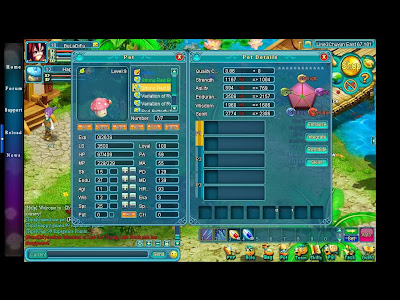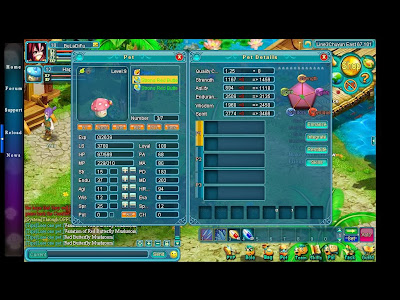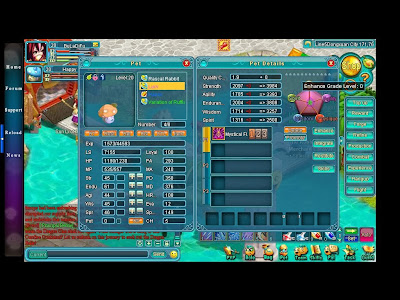Pets
- Humanoid - Have considerable advantage over mechanicals and a slight advantage over demons.
- Wild Beast - Have considerable advantage over humanoids and a slight advantage over mechanicals.
- Flora - Have considerable advantage over dragons and a slight advantage over wild beasts.
- Mechanical - Have considerable advantage over demons and a slight advantage over floras.
- Demon - Have considerable advantage over floras and a slight advantage over dragons.
- Dragon - Have considerable advantage over wild beasts and a slight advantage over humanoids.
| * Considerable: 20% increased effect | Slight: 10% increased effect |
To further individualize the pets, they are given a stat attribute system much like the player's own. For every level that the pet gains, it will be awarded with 5 stat points which the player can freely allocate. This literally means that you can mold the pet into whatever you require, a walking tank or a damage dealer.
Skills
Furthermore, these pets can also learn special skills to aid their masters in battles. Some of these skills are class-specific (limited by pet type) while others are not (can be learnt by all pet types).
Pets can acquire skills in a number of ways. They could have gotten those skills while they were still wild and untamed. However, these pets are rare and hard to find though. You can only count yourself lucky if you ever catch one. Next, whenever a pet levels up, they have a small chance to learn new skills or rank up existing ones. Lastly, it can be acquired from pet skill books. Just place the pet and the skill book into its corresponding boxes in the pet refining window under the skills tab (as shown in the picture).
Pet skills have 3 levels of proficiency. Apart from the natural ranking process as mentioned earlier, you can manually increase the rank of your pet's skill by using pet training books. To level the skill, just press the "promote" button found beside it once you have the required number of books.
Quality
On top of all these, pets also comes in varying qualities. The weakest ones usually have a white name while the strongest ones have an orange name.
- White (Base Quality Coefficient: Less than 1.10)
- Green (Base Quality Coefficient: Between 1.10 to 1.30)
- Blue (Base Quality Coefficient: Between 1.30 to 1.60)
- Purple (Base Quality Coefficient: Between 1.60 to 2.00)
- Orange (Base Quality Coefficient: Between 2.00 to 2.50)
Integration
Other than randomly catching a pet and hoping for it to be orange, you can synthesize your own via integration (found in the pet refining window). All you need is a lot of pet slots and patience. This is because the process of successfully integrating an orange pet is very tedious. For your information, we can expand up to a maximum of 30 slots using pets table expansion scrolls (found in mall shop at a price of 20 gold each).
The following is an explanation of the rules of integration.
- Integration can only be performed using pets of the exact same kind. You cannot integrate a green mushroom with ice mushrooms even though they're both flora and mushrooms. Furthermore, they must be of the same quality range (refer to color of their names).
- To integrate, you will need one primary pet and four secondary pets.
- After a successful integration, the base quality coefficient of the primary pet will increase while the four secondary pets will disappear.
- If integration fails, the primary pet will remain unchanged but the secondary pets will still disappear.
- The success rate of integration is as follow:
White to Green: 100%
Green to Blue: 80%Blue to Purple: 50%
Purple to Orange: 30%
Quality Coefficient, Base & Final Qualifications and Enhancement
So in what way does all these affect the pet? Although I do not totally understand the system, I do have a small hypothesis for this. If you take a look at your pet's details window, you will see a bunch of numbers like the quality coefficient and base qualifications for strength, agility, endurance, wisdom and spirit.

There is a variety of different internal pills and the quality of the internal pill will determine the amount that is increased (0.01 ~ 0.15) upon a successful enhancement. The success rate of enhancement is not known, but apparently penalty will ONLY be applied on pets that have been enhanced more than 7 times. The penalty for failure is a full reset of all the previous enhancements. The only way to avoid the penalty is when you use pills of internal blessing to "protect" the pet during enhancement.

Base qualification * Quality coefficient = Final qualification
The final qualification number determines the effectiveness of the stat points being allocated to that particular attribute. For example, if pet A has a final qualification number for strength that is less than pet B but they both have the same number of stat points being allocated to strength and are of the same level, you will notice that pet B has a higher attack power than pet A.
To support this hypothesis, the following are screenshots of the stats and details of pets in two different scenarios. The same species of pets is used in order to prevent the introduction of unwanted variables.
- Similar Base Quality Coefficient
The two pets used are of the same level, same stats and have similar base quality coefficient.
- Different Base Quality Coefficient
The two pets used are of the same level, same stats but have different base quality coefficient.
Restitution
Restitution gives the player a means to refresh and change the base qualifications of a pet. If you don't like the pet's base qualification for strength, you can give the pet a strength restitution pill. If you don't like its base qualification for agility, give it an agility restitution pill then. What the pill does is to reset the base qualification and then allocate it with a new random number. There appears to be a range for the randomly generated number (possibly for each species of pet) but that cannot be confirmed and is only my guess.
Alternatively, if you don't want to risk lowering your pet's base qualifications, you can opt to use an advance pill of restitution. These pills will increase the corresponding base qualification by a certain percentage instead. This percentage will be randomized with every use of the pill. This means that the effect will not be stacked by using multiples of these pills.
Rebirth
As previously mentioned, there is a range for the base quality coefficient for each colour of pets. If unfortunately you find yourself having a pet with a base quality coefficient in the lower end of the range, you can always feed it with a quality rebirth pill. This pill will reset the base quality coefficient to a new random number that is within the range of its colour. Only pets of green colour and above will be able to use these pills though.
Mirage
The mirage process offers players yet another means to boost the final qualifications of their pets. Through the use of a secondary disposable pet, the primary pet will be able to inherit a certain percentage of a particular base qualification of the secondary pet.
- If a purple secondary pet is used, base qualifications inherited is between 10% to 15%.
- If an orange secondary pet is used, base qualifications inherited is between 25% to 30%.
(Base + Mirage process qualification) * Quality coefficient = Final qualification
The following is an explanation of the rules of mirage.
- Only purple or orange pets can be used in the mirage process.
- Mirage process qualification cannot be stacked. When processed multiple times, only the most recent value will be retained.
- Mirage process success rate calculation.
Purple pets: 10% (each)
Purple holy beast pets: 15% (each)Orange pets: 15% (each)
Orange holy beast pets: 30% (each)- If both pets are of the same type, success rate is increased by 20%.
- If both pets are of different types, success rate is reduced by half.- Lucky stones can be used to increase the success rate by an additional 20% for each stone that is used.
- If the secondary pet used is purple, you can use either purple or orange lucky stones.
- If the secondary pet used is orange, you can only use orange lucky stones.
- You can use up to a maximum of 5 lucky stones to boost the success rate.* The holy beasts mentioned here are most probably pets bought from the item mall and not the ones you capture in the game via normal means.Example 1: Orange wild beast pet (Primary) & Purple wild beast pet (Secondary)
Success Rate = 15% (Primary's) + 10% (Secondary's) + 20% (Same Type)
= 45%
Example 2: Orange wild beast holy beast pet (Primary) , Purple flora pet (Secondary) & 3 lucky stones
Success Rate = {[30% (Primary's) + 10% (Secondary's)] / 2 (Different Type)}
+ 60% (Lucky Stones)
= 80%
| Previous: Magic Campus (Part Two) | Next: Magic Campus (Part Four) |
 Sunday, March 25, 2012
8:24 PM
Sunday, March 25, 2012
8:24 PM
 BuLaDiFu
BuLaDiFu



















 Posted in:
Posted in: 

